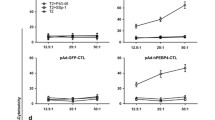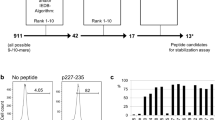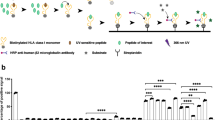Abstract
PIWIL2, a member of PIWI/AGO family, is expressed in germline stem cells and precancerous stem cells, but not in adult somatic cells. PIWIL2 plays an important role in tumor development. It is considered as a cancer–testis antigen (CT80). It has been reported that the spliced fragment of PIWIL2, PL2L60, was widely expressed in cancer cell lines. In this study, HLA-A2-restricted epitopes from PL2L60 were predicted by online tools. To improve the activity of the native epitope, a candidate peptide P281 with potent binding affinity was chosen to investigate the modification strategy. A series of aromatic amino acids were introduced to substitute the first residue of P281. Then, we tested the binding affinity and stability of the peptide analogs and their ability to elicit specific immune responses both in vitro and in vivo. Our results indicated that the cytotoxic T lymphocytes (CTLs) induced by [4-Cl-Phe1]P281 could elicit more potent activities than that of P281 and other analogs. The CTLs induced by this analog could lyze target cells in HLA-A2-restricted and antigen-specific manners. [4-Cl-Phe1]P281 also showed the best resistance against degradation in human serum. In conclusion, the introduction of the unnatural amino acid, 4-Cl-Phe, into the first position could enhance the activity of the native epitope to induce cytotoxic T lymphocytes. It might be a good strategy to modify other promising native epitopes. The novel epitopes identified in this study could be used as novel candidates to the immunotherapy of HLA-A2 positive patients with tumors expressing PL2L60.








Similar content being viewed by others
References
Kessler JH, Melief CJ (2007) Identification of T-cell epitopes for cancer immunotherapy. Leukemia 21:1859–1874
Uenaka A, Hirano Y, Hata H et al (2003) Cryptic CTL epitope on a murine sarcoma Meth A generated by exon extension as a novel mechanism. J Immunol 170:4862–4868
Shen H, Shao HW, Chen XH et al (2012) Identification of a novel HLA-A2-restricted mutated Survivin epitope and induction of specific anti-HCC CTLs that could effectively cross-recognize wild-type Survivin antigen. Cancer Immunol Immunother. doi:10.1007/s00262-012-1323-4
Rosenberg SA, Restifo NP, Yang JC, Morgan RA, Dudley ME (2008) Adoptive cell transfer: a clinical path to effective cancer immunotherapy. Nat Rev Cancer 8:299–308
Blattman JN, Greenberg PD (2004) Cancer immunotherapy: a treatment for the masses. Science 305:200–205. doi:10.1126/science.1100369305/5681/200
Bredenbeck A, Losch FO, Sharav T, Eichler-Mertens M, Filter M, Givehchi A, Sterry W, Wrede P, Walden P (2005) Identification of noncanonical melanoma-associated T cell epitopes for cancer immunotherapy. J Immunol 174:6716–6724
Ye Y, Yin DT, Chen L et al (2010) Identification of Piwil2-like (PL2L) proteins that promote tumorigenesis. PLoS One 5:e13406. doi:10.1371/journal.pone.0013406
Lazoura E, Apostolopoulos V (2005) Rational Peptide-based vaccine design for cancer immunotherapeutic applications. Curr Med Chem 12:629–639
Cole DK, Edwards ES, Wynn KK et al (2010) Modification of MHC anchor residues generates heteroclitic peptides that alter TCR binding and T cell recognition. J Immunol 185:2600–2610. doi:10.4049/jimmunol.1000629
Tirosh B, el-Shami K, Vaisman N, Carmon L, Bar-Haim E, Vadai E, Feldman M, Fridkin M, Eisenbach L (1999) Immunogenicity of H-2 Kb-low affinity, high affinity, and covalently-bound peptides in anti-tumor vaccination. Immunol Lett 70:21–28
Tu SH, Huang HI, Lin SI et al (2012) A novel HLA-A2-restricted CTL epitope of tumor-associated antigen L6 can inhibit tumor growth in vivo. J Immunother 35:235–244. doi:10.1097/CJI.0b013e318248f2ae
Valmori D, Fonteneau JF, Lizana CM et al (1998) Enhanced generation of specific tumor-reactive CTL in vitro by selected Melan-A/MART-1 immunodominant peptide analogues. J Immunol 160:1750–1758
van Stipdonk MJ, Badia-Martinez D, Sluijter M, Offringa R, van Hall T, Achour A (2009) Design of agonistic altered peptides for the robust induction of CTL directed towards H-2Db in complex with the melanoma-associated epitope gp100. Cancer Res 69:7784–7792. doi:10.1158/0008-5472.CAN-09-1724
Ruppert J, Sidney J, Celis E, Kubo RT, Grey HM, Sette A (1993) Prominent role of secondary anchor residues in peptide binding to HLA-A2.1 molecules. Cell 74:929–937
Tourdot S, Scardino A, Saloustrou E, Gross DA, Pascolo S, Cordopatis P, Lemonnier FA, Kosmatopoulos K (2000) A general strategy to enhance immunogenicity of low-affinity HLA-A2. 1-associated peptides: implication in the identification of cryptic tumor epitopes. Eur J Immunol 30:3411–3421. doi:10.1002/1521-4141(2000012)30:12<3411:AID-IMMU3411>3.0.CO;2-R
Gold JS, Ferrone CR, Guevara-Patino JA, Hawkins WG, Dyall R, Engelhorn ME, Wolchok JD, Lewis JJ, Houghton AN (2003) A single heteroclitic epitope determines cancer immunity after xenogeneic DNA immunization against a tumor differentiation antigen. J Immunol 170:5188–5194
Fischer PM (2003) The design, synthesis and application of stereochemical and directional peptide isomers: a critical review. Curr Protein Pept Sci 4:339–356
Gao YF, Sun ZQ, Qi F, Qi YM, Zhai MX, Lou HP, Chen LX, Li YX, Wang XY (2009) Identification of a new broad-spectrum CD8 + T cell epitope from over-expressed antigen COX-2 in esophageal carcinoma. Cancer Lett 284:55–61. doi:10.1016/j.canlet.2009.04.009
Gritzapis AD, Voutsas IF, Lekka E, Tsavaris N, Missitzis I, Sotiropoulou P, Perez S, Papamichail M, Baxevanis CN (2008) Identification of a novel immunogenic HLA-A*0201-binding epitope of HER-2/neu with potent antitumor properties. J Immunol 181:146–154
Chen F, Zhai MX, Zhu YH, Qi YM, Zhai WJ, Gao YF (2012) In vitro and in vivo identification of a novel cytotoxic T lymphocyte epitope from Rv3425 of Mycobacterium tuberculosis. Microbiol Immunol 56:548–553. doi:10.1111/j.1348-0421.2012.00470.x
Hui X, Chen H, Zhang S, Ma X, Wang X, Huang B (2011) Antitumor activities of recombinant human interferon (IFN)-lambda1 in vitro and in xenograft models in vivo for colon cancer. Cancer Lett 311:141–151. doi:10.1016/j.canlet.2011.07.004
Zhu B, Chen Z, Cheng X et al (2003) Identification of HLA-A*0201-restricted cytotoxic T lymphocyte epitope from TRAG-3 antigen. Clin Cancer Res 9:1850–1857
Wang RN, Wang YB, Geng JW, Guo DH, Liu F, Chen HY, Zhang HY, Cui BA, Wei ZY (2012) Enhancing immune responses to inactivated porcine parvovirus oil emulsion vaccine by co-inoculating porcine transfer factor in mice. Vaccine 30:5246–5252. doi:10.1016/j.vaccine.2012.05.077
Ding FX, Wang F, Lu YM, Li K, Wang KH, He XW, Sun SH (2009) Multiepitope peptide-loaded virus-like particles as a vaccine against hepatitis B virus-related hepatocellular carcinoma. Hepatology 49:1492–1502. doi:10.1002/hep.22816
Liu W, Zhai M, Wu Z, Qi Y, Wu Y, Dai C, Sun M, Li L, Gao Y (2011) Identification of a novel HLA-A2-restricted cytotoxic T lymphocyte epitope from cancer-testis antigen PLAC1 in breast cancer. Amino Acids. doi:10.1007/s00726-011-0966-3
Zhu YH, Gao YF, Chen F, Liu W, Zhai MX, Zhai WJ, Qi YM, Ye Y (2011) Identification of novel T cell epitopes from efflux pumps of Mycobacterium tuberculosis. Immunol Lett 140:68–73. doi:10.1016/j.imlet.2011.06.009
Tugyi R, Uray K, Ivan D, Fellinger E, Perkins A, Hudecz F (2005) Partial D-amino acid substitution: improved enzymatic stability and preserved Ab recognition of a MUC2 epitope peptide. Proc Natl Acad Sci USA 102:413–418. doi:10.1073/pnas.0407677102
Rammensee H, Bachmann J, Emmerich NP, Bachor OA, Stevanovic S (1999) SYFPEITHI: database for MHC ligands and peptide motifs. Immunogenetics 50:213–219
Parker KC, Bednarek MA, Coligan JE (1994) Scheme for ranking potential HLA-A2 binding peptides based on independent binding of individual peptide side-chains. J Immunol 152:163–175
Nielsen M, Lundegaard C, Worning P, Lauemøller SL, Lamberth K, Buus S, Brunak S, Lund O (2003) Reliable prediction of T-cell epitopes using neural networks with novel sequence representations. Protein Sci 12:1007–1017
Larsen MV, Lundegaard C, Lamberth K, Buus S, Lund O, Nielsen M (2007) Large-scale validation of methods for cytotoxic T-lymphocyte epitope prediction. BMC Bioinformatics 8:424
Schalich J, Vytvytska O, Zauner W, Fischer MB, Buschle M, Aichinger G, Klade CS (2008) Analysis of the human cytomegalovirus pp65-directed T-cell response in healthy HLA-A2-positive individuals. Biol Chem 389:551–559
Wu ZY, Gao YF, Wu YH, Liu W, Sun M, Zhai MX, Qi YM, Ye Y (2011) Identification of a novel CD8 + T cell epitope derived from cancer-testis antigen MAGE-4 in oesophageal carcinoma. Scand J Immunol 74:561–567. doi:10.1111/j.1365-3083.2011.02606.x
Traversari C, van der Bruggen P, Luescher IF, Lurquin C, Chomez P, Van Pel A, De Plaen E, Amar-Costesec A, Boon T (1992) A nonapeptide encoded by human gene MAGE-1 is recognized on HLA-A1 by cytolytic T lymphocytes directed against tumor antigen MZ2-E. J Exp Med 176:1453–1457
Goonetilleke N, Moore S, Dally L et al (2006) Induction of multifunctional human immunodeficiency virus type 1 (HIV-1)-specific T cells capable of proliferation in healthy subjects by using a prime-boost regimen of DNA- and modified vaccinia virus Ankara-vectored vaccines expressing HIV-1 Gag coupled to CD8 + T-cell epitopes. J Virol 80:4717–4728. doi:10.1128/JVI.80.10.4717- 4728.2006
Salmon-Ceron D, Durier C, Desaint C et al (2010) Immunogenicity and safety of an HIV-1 lipopeptide vaccine in healthy adults: a phase 2 placebo-controlled ANRS trial. AIDS 24:2211–2223. doi:10.1097/QAD.0b013e32833ce566
Croft NP, Purcell AW (2011) Peptidomimetics: modifying peptides in the pursuit of better vaccines. Expert Rev Vaccines 10:211–226. doi:10.1586/erv.10.161
Acknowledgments
This work was supported by grants from the National Natural Science Foundation of China (Nos. 81373228, 81172893) and the National Science and Technology Major Projects of New Drugs (2012ZX09103301-023).
Conflict of interest
The authors declare that they have no conflict of interest.
Author information
Authors and Affiliations
Corresponding author
Electronic supplementary material
Below is the link to the electronic supplementary material.
Rights and permissions
About this article
Cite this article
Shi, Rr., Liu, J., Zou, Z. et al. The immunogenicity of a novel cytotoxic T lymphocyte epitope from tumor antigen PL2L60 could be enhanced by 4-chlorophenylalanine substitution at position 1. Cancer Immunol Immunother 62, 1723–1732 (2013). https://doi.org/10.1007/s00262-013-1478-7
Received:
Accepted:
Published:
Issue Date:
DOI: https://doi.org/10.1007/s00262-013-1478-7




